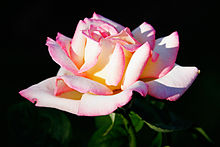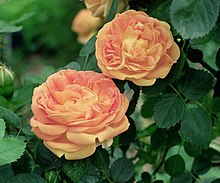Garden roses are mostly hybrid roses that are grown as ornamental plants in private or public gardens. They are one of the most popular and widely cultivated group of flowering plants, especially in temperate climates. Numerous cultivars have been produced, especially over the last two centuries, though roses have been known in the garden for millennia beforehand. While most garden roses are grown for their flowers, some are also valued for other reasons, such as having ornamental fruit, providing ground cover, or for hedging.
It is believed that roses were grown in all the early civilizations of temperate latitudes from at least 5000 years ago. They are known to have been grown in ancient Babylon. Records exist of them being grown in Chinese gardens and Greek gardens from at least 500 BC. Most of the plants grown in these early gardens are likely to have been either species collected from the wild, or selections from them.
The significant breeding of modern times started slowly in Europe, from about the seventeenth century. This was encouraged by the introduction of new species, and especially by the introduction of the China rose in the nineteenth century. An enormous range of roses has been bred since then, often grouped according to parentage, use or floral form.
Wild Roses
The wild roses (also known as species roses) include the natural species and some of their hybrids. The wild roses commonly grown in gardens include Rosa moschata, the Musk Rose; Rosa banksiae, Lady Banks' Rose; Rosa pimpinellifolia, the Scots or Burnet Rose; Rosa rubiginosa, the Sweetbriar or Eglantine; and Rosa foetida, in varieties Austrian Copper, Persian Double and Harison's Yellow. For most of these, the plants found in cultivation are often selected clones that are propagated vegetatively. Wild roses are low-maintenance shrubs in comparison to other garden roses, usually tolerating poor soil and some shade. They are generally once flowering, but some varieties display large rosehips in the autumn or have colourful autumn foliage.
Old Garden Roses
 An Old Garden Rose is defined as any rose belonging to a class which existed before the introduction of the first Modern Rose, La France, in 1867. In general, Old Garden Roses of European or Mediterranean origin are once-blooming woody shrubs, with notably fragrant, double-flowered blooms primarily in shades of white, pink and red. The shrubs' foliage tends to be highly disease-resistant, and they generally bloom only on two-year-old canes. The introduction of China and Tea roses from East Asia around 1800 led to new classes of Old Garden Roses which bloom on new growth, often repeatedly from spring to fall.
An Old Garden Rose is defined as any rose belonging to a class which existed before the introduction of the first Modern Rose, La France, in 1867. In general, Old Garden Roses of European or Mediterranean origin are once-blooming woody shrubs, with notably fragrant, double-flowered blooms primarily in shades of white, pink and red. The shrubs' foliage tends to be highly disease-resistant, and they generally bloom only on two-year-old canes. The introduction of China and Tea roses from East Asia around 1800 led to new classes of Old Garden Roses which bloom on new growth, often repeatedly from spring to fall. Classification of modern roses can be quite confusing because many modern roses have old garden roses in their ancestry and their form varies so much. The classifications tend to be by growth and flowering characteristics. The following includes the most notable and popular classifications of Modern Garden Roses:
Hybrid Tea
 The favourite rose for much of the history of modern roses, hybrid teas were initially created by hybridising Hybrid Perpetuals with Tea roses in the late 19th century. 'La France', created in 1867, is universally acknowledged as the first indication of a new class of roses. Hybrid teas exhibit traits midway between both parents: hardier than the teas but less hardy than the hybrid perpetuals, and more ever-blooming than the hybrid perpetuals but less so than the teas. The flowers are well-formed with large, high-centred buds, and each flowering stem typically terminates in a single shapely bloom. The shrubs tend to be stiffly upright and sparsely foliaged, which today is often seen as a liability because it makes them more difficult to place in the garden or landscape. Hybrid teas became the single most popular garden rose of the 20th century; today, their reputation as high maintenance plants has led to a decline in popularity. The hybrid tea remains the standard rose of the floral industry, however, and is still favoured in formal situations. Examples: 'Peace' (yellow), 'Garden Party' (white), 'Mister Lincoln' (red) and 'Double Delight' (bi-colour cream and red).
The favourite rose for much of the history of modern roses, hybrid teas were initially created by hybridising Hybrid Perpetuals with Tea roses in the late 19th century. 'La France', created in 1867, is universally acknowledged as the first indication of a new class of roses. Hybrid teas exhibit traits midway between both parents: hardier than the teas but less hardy than the hybrid perpetuals, and more ever-blooming than the hybrid perpetuals but less so than the teas. The flowers are well-formed with large, high-centred buds, and each flowering stem typically terminates in a single shapely bloom. The shrubs tend to be stiffly upright and sparsely foliaged, which today is often seen as a liability because it makes them more difficult to place in the garden or landscape. Hybrid teas became the single most popular garden rose of the 20th century; today, their reputation as high maintenance plants has led to a decline in popularity. The hybrid tea remains the standard rose of the floral industry, however, and is still favoured in formal situations. Examples: 'Peace' (yellow), 'Garden Party' (white), 'Mister Lincoln' (red) and 'Double Delight' (bi-colour cream and red).Pernetiana
The French breeder Joseph Pernet-Ducher initiated the first class of roses to include genes from the old Austrian briar rose (Rosa foetida) with his 1900 introduction of 'Soleil d'Or.' This resulted in an entirely new colour range for roses: shades of deep yellow, apricot, copper, orange, true scarlet, yellow bicolours, lavender, gray, and even brown were now possible. Originally considered a separate class, the Pernetianas or Hybrid Foetidas were officially merged into the Hybrid Teas in 1930. The new colour range did much to increase hybrid tea popularity in the 20th century, but these colours came at a price: Rosa foetida also passed on a tendency toward disease-susceptibility, scentless blooms, and an intolerance of pruning to its descendants.
Polyantha
Literally "many-flowered" roses, from the Greek "poly" (many) and "anthos" (flower). Originally derived from crosses between two East Asian species (Rosa chinensis and Rosa multiflora), polyanthas first appeared in France in the late 19th century alongside the hybrid teas. They featured short plants — some compact, others spreading in habit — with tiny blooms (2.5 cm or 1 inch in diameter on average) carried in large sprays, in the typical rose colours of white, pink and red. Their main claim to fame was their prolific bloom: From spring to fall, a healthy polyantha shrub might be literally covered in flowers, creating a strong colour impact in the landscape. Polyantha roses are still regarded as low-maintenance, disease-resistant garden roses today, and remain popular for that reason. Examples: 'Cecile Brunner', 'The Fairy', 'Red Fairy', 'Pink Fairy'.
Cultivation
 In the garden, roses are grown as bushes, shrubs or climbers. "Bushes" are usually comparatively low growing, often quite upright in habit, with multiple stems emerging near ground level; they are often grown formally in beds with other roses. "Shrubs" are usually larger and have a more informal or arching habit, and may additionally be placed in a mixed border or grown separately as specimens. Certain bush hybrids (and smaller shrubs) may also be grown as "standards", which are plants grafted high (typically 1 metre or more) on a rose rootstock, resulting in extra height which can make a dominant feature in a floral display. Climbing roses are usually trained to a suitable support.
In the garden, roses are grown as bushes, shrubs or climbers. "Bushes" are usually comparatively low growing, often quite upright in habit, with multiple stems emerging near ground level; they are often grown formally in beds with other roses. "Shrubs" are usually larger and have a more informal or arching habit, and may additionally be placed in a mixed border or grown separately as specimens. Certain bush hybrids (and smaller shrubs) may also be grown as "standards", which are plants grafted high (typically 1 metre or more) on a rose rootstock, resulting in extra height which can make a dominant feature in a floral display. Climbing roses are usually trained to a suitable support.Roses are commonly propagated by grafting onto a rootstock, which provides sturdiness and vigour, or (especially with Old Garden Roses) they may be propagated from hardwood cuttings and allowed to develop their own roots.
Most roses thrive in temperate climates. Those based on warm climate Asian species do well in their native sub-tropical environments. Certain species and cultivars can even flourish in tropical climates, especially when grafted onto appropriate rootstocks. Most garden roses prefer rich soil which is well-watered but well-drained, and perform best in well-lit positions which receive several hours of sun a day (although some climbers will tolerate shade). Standard roses require staking.

















0 comments:
Post a Comment